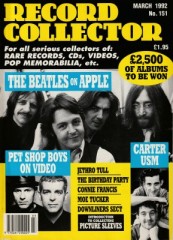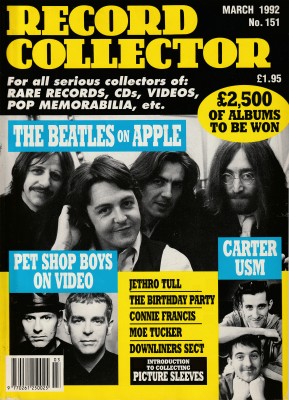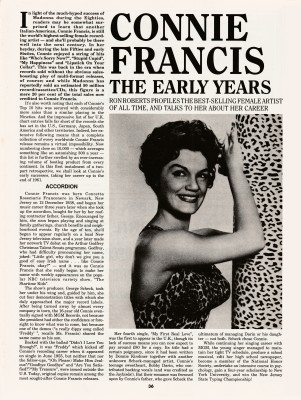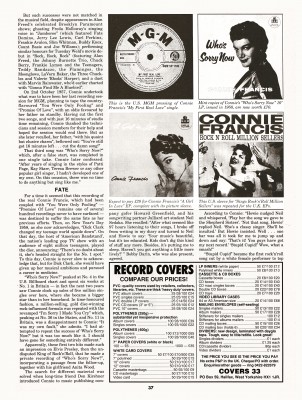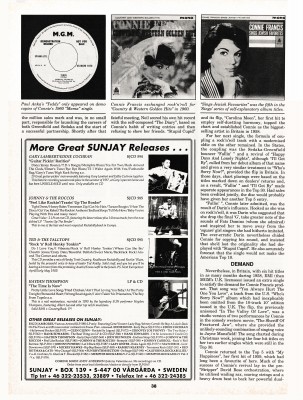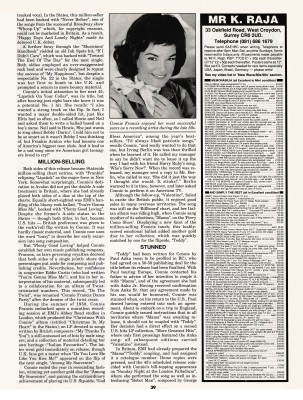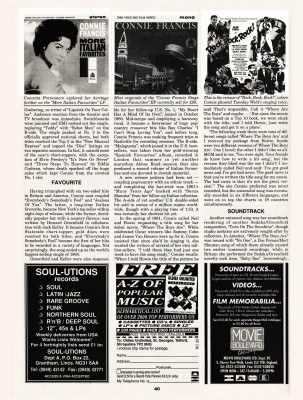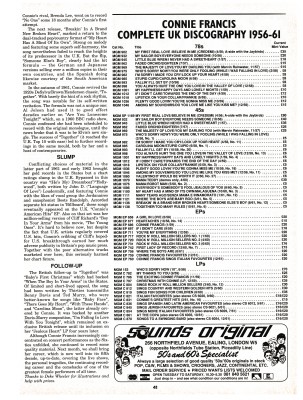In light of the much-hyped success of Madonna during the Eighties,
readers may be somewhat surprised to learn that another Italian-American, Connie Francis, is still the world's highest-selling female recording artist - and she'll probably be there well into the next century. In her heyday, during the late Fifties and early Sixties, Connie enjoyed a string of hits like ''Who's Sorry Now?'', ''Stupid Cupid'', ''My Happiness'' and ''Lipstick On Your Collar''. This was back in the era when records sold without the obvious sales- boosting ploy of multi-format releases, of course; and while Madonna has reportedly sold an estimated 50 million record/cassettes/CDs, this figure is a mere 20 per cent of the total sales now credited to Connie Francis.
It's also worth noting that each of Connie's Top 10 hits was secured with considerably more sales than a similar placing in the Nineties. And the impressive list of her U.K. chart entries falls far short of the records she has set in the U.S., Germany, Japan, South America and other territories. Indeed, her extensive following means that a complete collection of every worldwide Connie Francis release remains a virtual impossibility. Now numbering close on 10,000 which averages something like an astonishing 300 a year this list is further swelled by an ever-increasing volume of bootleg product from every continent. In this first instalment of a two-part retrospective, we shall look at Connie's early successes, taking her career up to the end of 1961.
ACCORDION
Connie Francis was born Concetta Rosemarie Franconero in Newark, New Jersey on 12 December 1938, and began her music career three years later when she took up the accordion, bought for her by her roofing contractor father, George. Encouraged by him, she soon began playing and singing at family gatherings, church benefits and neighbourhood events. By the age of ten, she'd begun to appear regularly on a local New Jersey television show, and a year later made her network TV debut on the Arthur Godfrey Christmas Talent Scouts programme. Godfrey, who had difficulty pronouncing her name, joked: ''Little girl, why don't we give you a good ol' easy Irish name.....like Connie Francis, okay?'' and it was as Connie Francis that she really began to make her name with weekly appearances on the popular NBC television variety show, ''The Startime Kids''.
The show's producer, George Scheck, took her under his Wing and, guided by him, she cut four demonstration titles with which she duly approached the major record labels. After being turned away by almost every company in town, the 16-year old Connie eventually signed with MGM Records, not because the president had either the confidence or foresight to know what was to come, but because one of the demos ("a really dippy song called 'Freddy' '', recalls Ms. Francis) shared the same name as his son.
Backed with the ballad ''Didn't I Love You Enough?'', it was ''Freddy'' which kicked off Connie's recording career when it appeared on a single in June 1955, but neither that nor the follow-ups, ''(Oh Please) Make Him Jealous"/"Goodbye Goodbye'' and ''Are You Satisfied?"/'My Treasure'', were issued outside the U.S. Today, original copies remain among the most sought-after Connie Francis releases.
Her fourth single, ''My First Real Love'', '' 'l' the first to appear in the U.K., though its lack L 1 success means you can now expect to pa.'. . round #80 for a copy. Its title had a cer[-'in poignancy, since it had been written by Poiinie Kirshner together with another unkne',\.n Scheck-managed artist, Connie's teen.-ige sweetheart, Bobby Darin, who con-trihlii4d backing vocals (and was credited as the 1.-',\'birds!). But their romance was frowned liy1::. bv Connie's father, who gave Scheck the ultimatum of managing Darin or his daugh-ter not both. Scheck chose Connie.
While continuing her singing career with MGM, the young singer managed to main-tain her tight TY schedule, produce a school musical, edit her high school newspaper, become a member of the National Honor Society, undertake an intensive course in psy-chology, gain a four-year scholarship to New York University, and win the New Jersey State Typing Championship!
But such successes were not matched in i.:'c musical field, despite appearances in Alan Freed's celebrated Brooklyn Paramount shows; ghosting Freda Holloway's singing voice in ''Jamboree'' (which featured Fats Domino, Jerry Lee Lewis, Carl Perkins, Frankie Avalon, Slim Whitman, Buddy Knox, Count Basie and Joe Willams); performing similar honours for Tuesday Weld's movie de-but in ''Rock, Rock, Rock'' (featuring Alan Freed, the Johnny Burnette Trio, Chuck Berry, Frankie Lymon and the Teenagers, 1'.ddy Randaszo, the Flamingos, the ''.1oonglows, LaVern Baker, the Three Chuck-les and Valerie 'Rhoda' Harper); and a duet with Marvin Rainwater, who'd earlier charted with ''Gonna Find Me A Bluebird''.
On 2nd October 1957, Connie undertook what was to have been her last recording ses-sion for MGM, planning to tape the country-flavoured ''You Were Only Fooling'' and ''Promise Of Love'', with an oldie favoured by her father on standby. Having cut the first Two songs, and with just 16 minutes of studio ime remaining, Connie thanked the techni-cians and session members for their help and hoped the session would end there. But as she later recalled, her father, ''with his quaint but elusive charm'', bellowed out: ''You've still got 16 minutes left. . . cut the damn song!''
That third song was ''Who's Sorry Now?'' which, after a false start, was completed in one single take. Connie later confessed: ''After years of singing in the styles of Patti Page, Kay Start, Teresa Brewer or any other popular girl singer, I hadn't developed one of my own. On this occasion, there was no time to do anything but sing like me.''
FATE
For a time it seemed that this recording of the real Connie Francis, which had been coupled with ''You Were Only Fooling" ''Promise Of Love'' remains one of several hundred recordings never to have surfaced was destined to suffer the same fate as her previous efforts. Then, on New Year's Day 1958, as she now acknowledges, ''Dick Clark changed my teenage world upside down''. On that day, the host of 'American Bandstand', the nation's leading pop 'TV show with an audience of eight million teenagers, played the disc, announcing: ''There's no doubt about it, she's headed straight for the No. 1 spot.'' To this day, Connie is never slow to acknow-ledge that, but for Dick Clark, she would have given up her musical ambitions and pursued a career in medicine.
''Who's Sorry Now?'' peaked at No. 4 in the U.S. Billboard chart and spent six weeks at No. 1 in Britain in fact the next two years saw Connie clock up sales of five million sin-gles over here, where she became a bigger star than in her homeland. In time-honoured fashion, a million-selling, gold disc-winning rock-influenced formula was repeated with the revamped ''I'm Sorry I Made You Cry'' which, peaking at No. 36 in the States, and No. 11 in Britain, was a disappointment to Connie: ''It was my own fault,'' she admits. ''I had at-tempted to repeat the success of 'Who's Sorry Now?' but it was too much like it. l should have gone for something entirely different.''
Apparently, these first two hits made such an impression on Elvis Presley, then the un-disputed King of Rock'n'Roll, that he made a private recording of ''Who's Sorry Now?'', incorporating a passage from the follow-up, together with his girlfriend Anita Wood.
The search for different material was solved when long-time friend Don Kirshner introduced Connie to music publishing com-pany gofer Howard Greenfield, and his songwriting partner Julliard art student Neil Sedaka. She recalled: ''After what seemed like 97 hours listening to their songs, I broke off from writing in my diary and turned to Neil and Howie to say: 'Your music's beautiful, but it's too educated. Kids don't dig this kind of stuff any more. Besides, it's putting me to sleep. Haven't you got anything a little more lively?' '' Bobby Darin, who was also present, arreed
According to Connie: ''Howie nudged Neil and whispered, 'Play her the song we gave to the Shepherd Sisters'. 'Not that song, Howie' replied Neil. 'She's a classy singer. She'll be insulted.' But Howie insisted. Well . . . one bar was all it took for me to jump up and down and say: 'That's it! You guys have got my next record.' 'Stupid Cupid!' Wow, what a smash!''
''Stupid Cupid'' became the first rock'n'roll song cut by a white female performer to top the million sales mark and was, in no small part, responsible for launching the careers of both Greeniield and Sedaka and the start of a successful partnership. Shortly after that fateful meeting, Neil scored his own hit record with the self-composed ''The Diary'', based on Connie's habit of writing entries and then refusing to show her friends. ''Stupid Cupid'' and its flip, ''Carolina Moon'', her first hit to employ selfduetting harmony, topped the chart and established Connie as the biggest- selling artist in Britain in 1958.
For her next single, the formula of cou-pling a rock'n'roll track with a modernised oldie on the other remained. In the States, the coupling was the Sedaka-Greenfield bouncer ''Fallin' '' and a revival of ''Happy Days And Lonely Nights'', although ''I'll Get By'', culled from her debut album of that name and given a very similar treatment to ''Who's Sorry Now?'', provided the flip in Britain. In those days, chart placings were based on the titles marked down on dealers returns and, as a result, ''Fallin' '' and ''I'll Get By'' made separate appearances in the Top 30. Had sales been credited jointly, the disc would probably have given her another Top 5 entry.
''Fallin' '', Connie later admitted, was the result of Darin's influence. Hooked as she was on rock'n'roll, it was Darin who suggested that she drop the final 'G', take greater note of the sounds of Fats Domino (whom she admired) and inspired her to move away from the 'square' girl singers she had hitherto imitated. The ever-erratic Darin nevertheless chided Connie for copying his sound, and insisted that she'd lost the originality she had dis-played with ''Stupid Cupid''. He also accurately forecast that the single would not make the American Top 10.
DEMAND
Nevertheless, in Britain, with six hit titles in as many months during 1958, EMI (then MGM's U.K. licensees) issued an extra single to satisfy the demand for Connie Francis prod-uct. That song was ''You Always Hurt The One You Love'', a track from the U.S. ''Who's Sorry Now?'' album which had inexplicably been omitted from the 10-track 10" edition issued in the U.K. The flip, the previously unissued ''In The Valley Of Love'', was a studio version of two performances by Connie in the comedy western movie. ''The Sheriff Of Fractured Jaw'', where she provided the unlikely-sounding combination of singing voice to Jayne Mansfield! The song charted during Christmas week, joining the four hit titles on her two earlier singles which were still in the Top 30.
Connie returned to the Top 5 with ''My Happiness'', her first hit of 1959, which had long been a favourite of hers. Much of the success of Connie's revival lay in the pre-"Stripper'' David Rose orchestration, where he utilised wailing sax, soaring strings and a heavy drum beat to hack her powerful dual- , 'ked vocal. In the States, this million-seller ,,d been backed with ''Never Before'', one of the songs from the successful Broadway show Whoop-Up'' which, for copyright reasons, could not be marketed in Britain. As a result, -Happy Days And Lonely Nights'' made its delayed U.K. debut.
A further foray through the ''Musicians' Handbook'' yielded an old Ink Spots hit, ''If I Didn't Care'', which was backed with ''Toward The End Of The Day'' for the next single. I- ,jth oldies employed an over-exaggerated
clt beat and were clearly designed to repeat tie success of ''My Happiness'', but despite a respectable No. 22 in the States, the single was her first to bomb in the U.K. and prompted a return to more bouncy material.
Connie's initial attraction to her next 45, 'Lipstick On Your Collar'', was its title, but after hearing just eight bars she knew it was a potential No. 1 hit. She recalls: ''I also wanted a strong track on the flip. In fact, I ''anted a major double-sided hit, just like ''jlvis had so often, so I called Howie and Neil . nd asked them to write a ballad based on a boy's name. Neil said to Howie, 'She just wants to sing about Bobby (Darin)'. I told him not to he so smart as it wasn't Bobby I was thinking of, but Frankie Avalon who had become one of America's biggest teen idols. And it had to be a sad song since we American girl teenag-ers loved to cry!''
MILLION-SELLING
Both sides of this release became Stateside million-selling chart entries, with ''Frankie'' eclipsing ''Lipstick'' as the major force in New York. Somewhat surprisingly, Connie's dedi-cation to Avalon did not get the double A-side treatment in Britain, where she had already placed both sides of a disc at the top of the charts. Equally short-sighted was EMI's han-dling of the bluesy rock ballad, ''You're Gonna Miss Me'', backed with ''Plenty Good Loving''. Despite the former's A-side status in the
States though both titles, in fact, became
U.S. hits British preference was given to the rock'n'roll flip written by Connie. It was hardly classic material, and Connie now uses the word ''lousy'' to describe her early excur-sion into song composition.
But ''Plenty Good Loving'' helped Connie establish her own music publishing company, Fr:incon. as laws governing royalties decreed that both sides of a single jointly share the percentages put aside for composing and pub-lishing credits. Nevertheless, her confidence in songwriter Eddie Curtis (who had written ''You're Gonna Miss Me"), and his in her in-terpretation of his material, subsequently led to a collaboration for an album of Twist-orientated numbers. This record, ''Do The Twist'', was renamed ''Connie Francis Dance Party'' after the demise of the twist craze.
During the summer of 1959, Connie Francis embarked upon a marathon record-ing session at EMI's Abbey Road studios in London, which produced the ''Christmas With Connie'' album (retitled ''Christmas In My Heart'' in the States); an LP devoted to songs written by British composers ("My Thanks To You"); a still-unissued set of hits by male sing-ers; and a collection of material detailing her own heritage ("Italian Favourites"). The lat-ter went gold immediately on release, though U.K. fans got a taster when ''Do You Love Me Like You Kiss Me?'' appeared on the flip of the next single, ''Among My Souvenirs''.
Connie ended the year in resounding fash-ion, winning yet another gold disc for ''Among My Souvenirs'', and gaining the extraordinary achievement of placing its U.S. flip-side, ''God Bless America'', among the year's best-sellers. ''I'd always liked patriotic songs,'' recalls Connie, ''and really wanted to do that one, but Irving Berlin was less than thrilled when he learned of it. He called my manager to say he didn't want me to louse it up the way I had with his friend Harry Ruby's song, 'Who's Sorry Now?'. When the record was re-leased, my manager sent a copy to Mr. Ber-lin, who called to say, 'She did it just the way I thought she would. It stinks!'.'' Berlin warmed to it in time, however, and later asked Connie to perform it on American TV.
Although the follow-up, ' alentino'', failed to excite the British public, it enjoyed good sales in many overseas territories. The song was still on the 'Billboard' chart, and her Ital-ian album was riding high, when Connie sang another of its selections, ''Mama'', on the 'Perry Como Show'. Displaying a new facet of the million-selling Francis touch, this lushly- scored emotional ballad added another gold disc to her collection, which was quickly matched by one for the flipside, ''Teddy''.
STUNNED
''Teddy'' had been written for Connie by Paul Anka (soon to be profiled in RC), who had agreed on a 50-50 publishing deal for the title before its release had been finalised. With Paul touring Europe, Connie contacted his father to advise of her intention to couple it with ''Mama'', and of the agreement she had with Anka Jr. Having received confirmation from Anka Sr. that any agreement made by his son would be honoured, Connie was stunned when, on his return to the U.S., Paul denied having entered into such an agree-ment. About to embark on a trip to England, Connie quickly issued instructions that in all territories where ''Mama'' 'was awaiting re-lease, it should not be coupled with ''Teddy''. Her decision had a direct effect on a second U.S. hits LP collection. ''More Greatest Hits'', where only first pressings featured the Anka song: all subsequent editions carried ''Valentino'' instead.
In Britain, EMI had already prepared the ''Mama"/"Teddy'' coupling, and had assigned it a catalogue number. Demo copies were pressed, and the 45's scheduled release coin-cided with Connie's bill-topping appearance on ''Sunday Night at the London Palladium'', where she performed the song as well as in-troducing ''Robot Man''. composed by George Goehering, co-writer of ''Lipstick On Your Col-lar''. Audience reaction from the theatre and 'TV broadcast was immediate. Switchboards were jammed and EMI rushed out the single replacing ''Teddy'' with ''Robot Man'' on the B-side. The single peaked at No. 2 in the officially approved national charts, but both titles reached the Top 3 in the ''New Musical Express'' and topped the ''Disc'' listings on two separate occasions. In fact, it outsold most of the year's chart-toppers, with the excep-tion of Elvis Presley's ''It's Now Or Never'' and ''Three Steps To Heaven'' by Eddie Cochran, whose death sparked off the huge sales which kept Connie from the coveted No. 1 slot.
FAVOURITE
Having triumphed with six two-sided hits in Britain and America, Connie next coupled ''Everybody's Somebody's Fool'' and ''Jealous Of You''. The latter, a long-time Italian favourite, became New York's top seller within eight days of release, while the former, decid-edl!' popular but with a country flavour, was written by Howard Greenfield in collabora-tion with Jack Keller. It became Connie's first Stateside chart-topper; gold discs were received for both titles; and 'Everybody's Somebody's Fool'' became the first of her hits to be recorded in a variety of languages. Not surprisingly, the song ended up as the world's biggest-selling single of 1960.
Greenfield and Keller were also responsi-
ble for her follow-up U.S. No. 1, ''My HeartHas A Mind Of Its Own'', issued in October 1960. Mid-tempo and employing a harmony vocal, it became a forerunner of huge pop/ country crossover hits like Ray Charles' ''I Can't Stop Loving You'', and before long, Connie Francis was making frequent trips to Nashville for recording sessions. The B-side, ''Malaguena'', which joined it in the U.S. best-sellers, was taken from her gold-winning ''Spanish Favourites'' album, recorded in London that summer in yet another marathon Abbey Road session that also produced a second volume of Italian favour-ites and one devoted to Jewish material.
A new release pattern had been set - coupling pop/country with an ethnic track - and completing the hat-trick was 1961's ''Many Tears Ago'' backed with ''Senza Mamma'' from her follow-up Italian collection. The A-side of yet another U.S. double-sided hit sold in excess of a million copies world-wide, though with a playing time of 1:53, it was certainly her shortest hit yet.
In the spring of 1961, Connie called Neil and Howie requesting a title song for her debut movie, ''Where The Boys Are''. While celebrated Oscar winners like Sammy Cohn and James Van Heusen were up for it, Connie insisted that since she'd be singing it, she wanted the writers of several of her own mil-lion-sellers. ''I told them they had just one week to have the song ready,'' Connie recalls. 'When I told Howie the title of the picture he said 'That's impossible. Call it ''Where Are The Boys'' and maybe. . 'But since the movie was based on a Top 10 book, we were stuck with the title, and I told Howie, just write the song and get it on a plane'.
''The following week there were tons of dif-ferent songs called 'Where The Boys Are' and I received my package from Howie. Inside were two different versions of ere The Boys Are'. One I loved; the other I didn't like at all. MGM said to me, 'You were right. Your friends do know how to write a hit song', but the version they liked was the one I didn't! I im-mediately called Neil and said: 'I've got good news and I've got bad news. The good news is that you've written the title song for my movie. The bad news is that it's not the great ver-sion'.'' The one Connie preferred was never recorded, but the successful song was eventu-ally recorded in six different languages, and went on to top the charts in 19 countries simultaneously.
SOUNDTRACK
Another unissued song was her soundtrack rendering of another Sedaka/Greenfield composition, ''Turn On The Sunshine'', though studio acetates are extremely sought-after by collectors. In America, ''Where The Boys Are'' was issued with ''No One'', a Doc Pomus/Mort Shuman song of which there already existed two earlier (unissued) recordings, while in Britain she performed the Sedaka/Greenfield novelty rock item, ''Baby Roo''. Interestingly,
1onnie's rival, Brenda Lee, went on to record No One'' some 18 months after Connie's first attempt.
The next release, ''Breakin' In A Brand New Broken Heart'', marked a return to the dual-tracked pop/country format of ''My Heart Has A Mind Of Its Own''. Strong on melody and featuring some superb self-harmony, the song nevertheless failed to reach the heights of its predecessor in the U.K. But the flip, Someone Else's Boy'', clearly had the hit aeormula - the German and Japanese '.'ersions selling over a million copies in their own countries, and the Spanish doing likewise courtesy of the South American market.
In the autumn of 1961, Connie revived the 1920s DeSylva/Brown/Henderson classic, ''To-gether''. With barely the hint ofa rock rhythm, the song was notable for its self-written recitation. The formula was not a unique one: Al Jolson had used it to good effect decades earlier on ''Are You Lonesome Tonight?'' which, on a 1960 BBC radio show, Connie confessed she had been scheduled to record with the original monologue, until the news broke that it was to be Elvis's new sin-gle. The success of ''Together'' (it reached the U.K. Top 10 with ease) led to further record-ings in the same mould, both by her and a host of contemporaries.
SLUMP
Conflicting choices of material in the latter part of 1961 and early 1962 brought her gold records in the States but a chart ratings slump in the U.K. Bypassed in this country was ''(He's My) Dreamboat"/"Holly-wood'', both written by John D. ("Language Of Love") Loudermilk, and featuring Connie with the likes of vocal group the Jordanaires and saxophonist Boots Randolph. Accorded separate hit status in 'Billboard', these songs eventually appeared on the U.K. ''Connie's American Hits'' EP. Also on that set was her million-selling version of Cliff Richard's ''Boy In Your Arms'' from his movie, ''The Young Ones''. It's hard to believe now, hut despite the fact that U.K. artists regularly covered U.S. hits, Connie's cribbing of Cliffs hoped- for U.S. breakthrough earned her much adverse publicity in Britain's pop music press. Together with the poor alternative tracks marketed over here, this seriously harmed her chart future.
FOLLOW-UP
The British follow-up to ''Together'' was ''Baby's First Christmas'' which had backed ''When The Boy In Your Arms'' in the States. Of limited and short-lived appeal. the song had been written by Thirties tunesmiths Benny Davis and Ted Murry, who were better-known for songs like ''Baby Face'', ''There Goes My Heart'', ''With These Hands'', and ''Carolina Moon'', the latter already cov-ered by Connie. It was backed by another Davis-Murry composition, ''I'm Falling In Love With You Tonight'', which remained an exclusive British release until its inclusion on her ''Jealous Heart'' LP four years later.
Although Connie Francis increasingly con-centrated on concert performances as the Six-ties unfolded, she continued to record some quality material. Next month, we shall bring her career, which is now well into its fifth decade, up-to-date, covering the live shows, the personal tragedies, the continuing record-ing career and the comebacks of one of the greatest female performers of all time.
Thanks to Dehe Wheeler for illustrations and help with prices.





